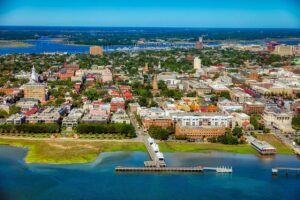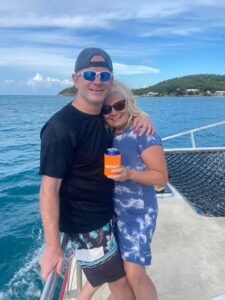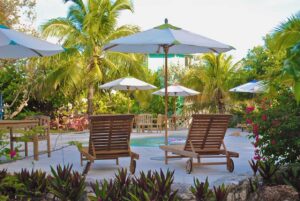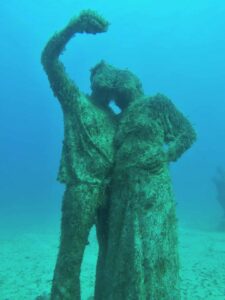Kia Koropp, along with her husband John, and two children Braca, 6 and Ayla, 4, began cruising around the world on their 50-foot sailboat, Atea, in 2011. This is an excerpt from their adventures in the Maldives, an island chain located in South Asia on the Indian Ocean.
After two months exploring the glorious Maldives, I’ve come full circle in appreciating what it has to offer. We’d heard numerous accounts from cruisers before us: Once in the Maldives, we would swim with manta rays, dive with whale sharks and suffocate from the density of fish in the live corals. The bar was set high, but keeping the bar high became a challenge as we discovered that the Maldives’ idyllic isles were either submerged under a thin layer of water or dominated by five-star resorts. After a bit of hit and miss, the delights of the Maldives finally unraveled before us.
We tackled the country in a three-pronged approach: one, uninhabited isles; two, remote villages; three, luxury resorts. These three perspectives proved to be the trifecta. The isolated islets offered pristine beauty and an opportunity to experience the rich underwater world. In the sleepy villages, we met fast and dear friends, while the resorts gave us a taste of the ultimate in high-end luxury.
UNINHABITED ISLETS
At first, the list of anchorages in the Maldives’ countless isles seemed in nite, but our planning was complicated by the fact that the names were impossible to remember.
Eventually we gave up trying to organize a route and simply drifted northward with a vague agenda. The problem with a strategy based on ambiguity and spontaneity, however, was that the topography didn’t lend itself to just hopping around.
The country’s countless islands — 1,190 to be exact — to anyone with a few months to explore by yacht, this offers more than enough options. In fact, it was a bit daunting to start navigating our yacht through the labyrinth. But there are limits, as we soon found out. The depths in the area are great and the drop-offs sheer, so we often found ourselves completely cut off from the islands. The land does not gently slope into deep water but quickly plunges from one to 50 meters on a vertical wall, making anchoring impossible. We passed idyllic isle after idyllic isle, wishing to park and play. It was evident looking through the clear water what made diving in the Maldives so extraordinary, with steep walls layered in coral and striped fish, but we were repeatedly denied access to this wonderland by depths too deep or shores too shallow.
What’s more, the bounty of coral reefs make boating feasible only in good light and with reliable charts. Prior to our arrival, John had spent considerable time downloading Google Map images of the region, providing us with visual details of the landscape. I highly recommend this to any yacht destined for these waters.
Journal Entry 1
Huvadhoo Atoll: The light is fading and I stand on the bow trying to spot white sand beneath the surface. We’ve sailed along the eastern fringe of the atoll for hours now, but it seems the entire eastern side is a sheer drop off. I continue to scout ahead. We shared paths with dolphin and pilot whales, but neither are what we search for. Finally, we concede defeat. John pulls up Google Map images of the area and we search the interior of the atoll for a submerged reef with enough depth to set our anchor. We look through the images for a shade of blue just the right hue: Too light and it is just knee deep, too dark and it is beyond the reach of our anchor windlass. Quickly, we find a spot two miles distant. Half an hour and we see a patch of sand that stands out like a halo. We made it. With the anchor set, we listen to the collective rush of a million little silver fish breaking the surface. In the pastel tinted light of the setting sun, it is the only sound that punctuates the intense quiet that engulfs us. It is intensely serene.
On many occasions we set our sights on a seemingly suitable anchorage only to find there wasn’t anything on the surface to explore or anywhere suitable to set our anchor. Our first few anchorages were no more than a submerged reef in the middle of the atoll, cut off from the beautiful islets that surrounded us. At first, this offered seclusion we were keen to avoid, but after realizing the splendor below us, we quickly turned our isolation into an opportunity.
Journal Entry 2
Hadhdhunmathee Atoll: The water is crystal clear and the fans that wave just below the surface beckon us. At low tide, the small circle of reef is the size of a tennis court and breaks the surface at its highest peak at low tide. The tide is high now, however, and we have a 360-degree view of endless blue. The four of us leap off the side deck into the water and snorkel in the breaking morning light. Seconds later we cannot see each other through the density of fish that engulf us. It is like a scene in an animation film, though this isn’t an over-exaggeration of the reef.
Live-aboard dive boats offer a great way to explore the area.
Journal Entry 3
Felidhe Atoll: While John dives, the kids and I snorkel alongside a mammoth moray eel. It’s large, outstretched body gracefully navigates the nooks of the reef. Eventually he catches his meal.
North Ari Atoll: Never before have I watched a reef shark hunt. I hover on the wall, pulling in shallow steady breaths on my regulator hose, and watch the shark directly below me. In a flash it sinks his head into a hole in the reef and retracts it wildly, thrashing its head like a dog with a bone. He caught his meal and I caught my breath.
Rasdhoo Atoll: I’ve often been a pest to the fish but rarely have the fish been a pest to me. Today’s dive was brimming with sh life, so thick that at times it was impossible to focus.
INHABITED ISLANDS
We’d been told our trip highlights would come from the water and not from the land, that the locals were indifferent to visitors and that we should expect a cold eye and frozen glare when going ashore.
Regardless, we ventured into villages with eyes wide open and were quickly reminded that what you hear is often not what you get. The warmth we found from the villagers was a defining feature of our trip. We were hosted and we hosted, our social customs and theirs traded like much-valued secrets. We learned to accept a type of hospitality very different from our own: guests are fed first and hosts second. We were offered coconuts from trees and guidance in the streets. The kids have been invited on play dates and picnics.
In many countries I have visited, I’ve found a social barrier that is hard to bridge, no matter how generous the gestures, but I never felt this in my interactions with the Maldivians. Most of the time, we experienced warmth and inclusion and I treasure what this added to our trip.
The pace of life in the Maldives is slow, a result of both the afternoon heat and a lack of industry. The coral-brick homes are surrounded by compound walls, set on neat sandy streets.
Journal Entry 4
Kolhumadulu Atoll: The four of us are seated at the table, with a cat underneath, a bird in a cage behind me and a parrot presented on an outstretched finger. Mother, sister and sister-in-law clatter about busily at the stove, the two daughters deliver plates piled high with local fare. At the end of the meal my contribution, a flan, is served to us. So far, no one else has eaten. We are introduced to visitors that appear in the doorway, a steady stream of neighborly curiosity. At the end of the evening we are presented a package, a gift of pre-purchased treats and an odd assortment of vegetables from the garden, and they escort us back to our dinghy.
The population of 373,000 is spread across 200 inhabited islands, with 50 percent of the citizens residing in the densely populated capital, Malé. The city is constructed one meter above sea level with half of its land base coming from the dredged sand of nearby islets.
It is incredible to think that the natural geography of the entire archipelago is lower than our aft deck.We sit on our perch like little seabirds and look down at the islands that surround us.
RESORTS
We wormed our way into the grace of a few sympathetic resort managers and paid our way in meals and cocktails, salons and shops, without having to pay for a room. We shared the facilities with Chinese, German, English and Russian tourists, the bulk of foreign visitors to the Maldives. Couples steeped in love held hands and wandered down the beach or lounged on decks hanging over the reefs. The Maldives is ranked as the world’s most desired honeymoon destination —thus the luxury resorts.
Journal Entry 5
Baa Atoll: Dinghy ashore, a hand on the scruff of the neck and a complimentary golf-cart ride to reception, where we get told to take a room or beat it. Regardless, I’m dogged in my fruitless pursuit of five-star luxury. Once more we are herded to reception, but before the golf cart can pull up for our return trip to the dinghy, I grab the kids and wander off to watch the shark feeding. Soon we have a fake guest room, an open tab and all amenities at our disposal. We spend the next few days living resort-style, hand-in-hand (when not hand-on-cocktail) and Cupid-struck.
Tourism has boomed in the Maldives since 1972. For almost 30 years, multinationals had exclusive rights on tourist development, with minimum revenue going to the local economy. The vast majority of resorts consisted of an exclusive hotel on its own island, managed by foreigners and with no contact with the local community. Tourists were restricted to the resorts, and cruisers were banned from anchoring off any populated islands. The authorities did not welcome independent travelers. In recent years, the government has eased restrictions, legalizing tourism development on a local level. Guest- houses, cafes, dive shops and souvenir shops burgeoned throughout the local villages, and more than a million tourists currently visit the country each year. Still, particularly in the south where tourism has been slower to develop, a foreigner can still be seen as an anomaly.
Journal Entry 6
Foammulah Atoll: We are in the southern atolls and we’ve not seen a single foreigner since our arrival two weeks prior. We’ve passed a few scattered resorts, but rarely stray from dive boat or resort. We’ve been at anchor for four days now, arriving mere hours before a big storm. We finally leave the boat for a much- needed leg stretch and play on the tiny islet where we are anchored. On the nearby main island, I see four bodies marching in line out to sea, arm- in-arm, heading our way. The water is deep in places, the current strong. They drag one another along. As they near I make out four women in full dress. I wade out to greet them, smiling as they puff from the exertion.
There is no conclusion to this story, for it is not yet concluded. We are on our way to India but will be returning to the Maldives soon for another shot at the trifecta. After all, of 1,190 islets, we’ve still a few yet to see.





